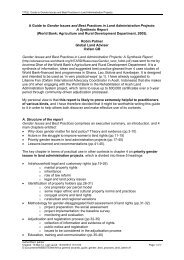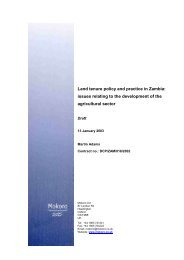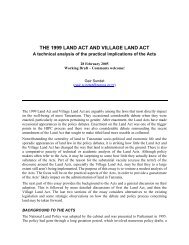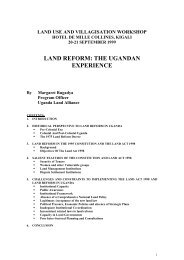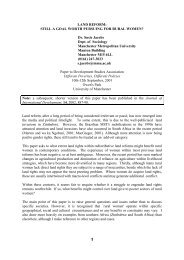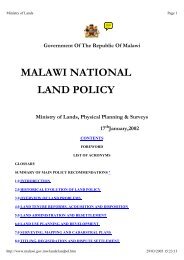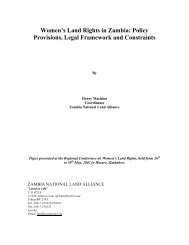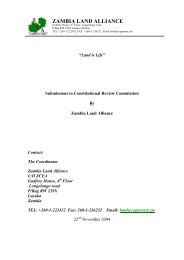Download - Mokoro
Download - Mokoro
Download - Mokoro
- No tags were found...
Create successful ePaper yourself
Turn your PDF publications into a flip-book with our unique Google optimized e-Paper software.
40conditions for success can be isolated from the international literature on transitions tosmallholder production.First, where there is an insistence by the state on changing the structure of ownership, astate-led, coordinated overall plan can be successful when associated with targetingland acquisition in specific areas, acquiring land in bulk, and investing in planning andsubdivision. This ideally requires a balance between a planned approach by the state,and decentralised and flexible adaptation through participatory processes at a local level(Alexander 1994).A second condition has been the promotion within redistributive land reforms of acombination of production of food crops for consumption and a surplus for sale with cashcrops for the market, along with livestock production. Rather than establishing cashcroppers entirely dependent on the vagaries of product market prices and, even worse,on a single commodity, in practice if not always in theory successful land reforms havesupported diversified land uses that minimise risk and enable smallholders to decidewhether to consume or sell, depending on the harvest, prices, and the state of their othersources of income and livelihood. This might extend to access to large scale processingof products like tea, sugar, wine, through contracts with private processing plants orcooperatives handling marketing and processing, like cotton ginning.A third condition is the public provision of extension services, readily available andpossibly subsidised inputs, credit (not limited to land as the only basis for security) forseasonal inputs and improvements appropriate to smallholder production (e.g. draughtpower) and infrastructure required by small producers. This may include extensionagents dedicated to servicing a specific population of smallholders pioneering someproduct in an area, subsidised seed, fertilizer, implements, fencing, and provision ofdipping tanks and veterinary services.A fourth condition is the provision of a marketing environment specifically suited to smallproducers: the creation of incentives for private marketing agents to buy small quantitiesof produce, cooperatives to enable the sorting, grading and marketing of produce, and insome instances price support to staple commodities in which smallholder producerspredominate.This brief review of international experience demonstrates that some of what is beingdiscussed in South Africa – a restructuring of agriculture away from the large-farm modeland towards a more mixed farming sector with a growing number of smallholders – isachievable, and has been achieved elsewhere in countries with more constrained publicfinances than South Africa’s. The above constitutes an agenda for the types of supportto be provided to smallholders, and for the role of the state in particular in makingavailable this support. This is not to say that the private sector cannot, or will not, play arole. As seen above, a variety of private sector initiatives in South Africa have attemptedto support ‘emerging farmers’, but are generally not directed towards producers whooperate on a small scale and whose production is not entirely for the market. Rather,what may be needed is a combination of direct state support and interventions geared tochanging the behaviour of the private sector in favour of small producers.Policy Options for Land and Agrarian ReformProgramme for Land and Agrarian Studies, University of the Western Cape




